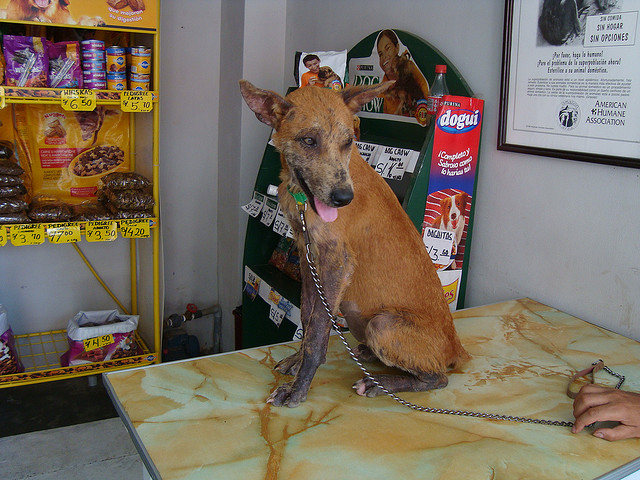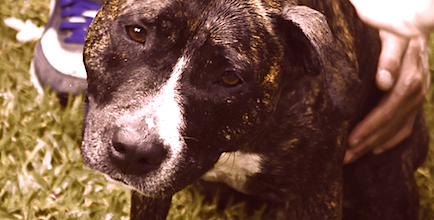Understanding Mange in Dogs: Types, Symptoms, and Treatments
Learn about mange in dogs, including types, symptoms, and effective treatments to keep your pet healthy and comfortable. Early diagnosis is key!

This pet health content was written by a veterinarian, Dr. Debora Lichtenberg, VMD, with contributions from Dr. Pippa Elliott, BVMS, MRCVS. This article was reviewed for accuracy by Dr. Elliott and was last updated on November 19, 2024

- Demodectic vs. Sarcoptic Mange:
- Diagnosing Demodectic vs. Sarcoptic Mange
- Sarcoptic Mange: Highly Infectious
- Symptoms of Sarcoptic Mange
- Skin Scrape to Diagnose Mange in a Dog
- Treatment for Demodectic Mange
- Treatment for Sarcoptic Mange
- The Problem With Collies
- Natural Remedies for Mange
- Treatment Failures
- Dog Breeds Most Likely to Get Demodectic Mange
- Hereditary?

Don’t leave your pet’s safety to chance
Sign up for Petful recall alerts today.

Types of Mange in Dogs
Mange in dogs comes in two common forms, each caused by different mites:
- Demodex: Caused by the Demodex mite.
- Sarcoptes: Caused by the Sarcoptes scabiei mite, commonly referred to as scabies.
When people describe a stray dog as a “mangy animal,” they are usually referring to the thickened skin and hair loss caused by sarcoptic mange. This condition is highly associated with itching—just talking about it might make you want to scratch!
Demodectic vs. Sarcoptic Mange in Dogs
Mange in dogs presents differently depending on whether it’s demodectic or sarcoptic mange. Here’s a breakdown of their key differences:
Demodectic Mange
- Usually not very itchy unless it progresses to a generalized form.
- Common in puppies and young dogs.
- Begins with small hairless patches (alopecia). Learn more about alopecia in dogs.
- Can appear as localized or generalized forms.
- Not contagious to other animals or people.
Sarcoptic Mange
- Extremely itchy!
- Can affect any dog, regardless of age or breed.
- Commonly affects the ears, elbows, and ventral areas.
- Highly contagious to other pets.
- Can infect humans, but symptoms usually resolve quickly.
The Fear of Mange Diagnosis
Many pet owners panic when hearing a diagnosis of mange in dogs. This reaction often stems from outdated beliefs that mange was untreatable or incredibly hard to manage. Images of a “mangy” dog scavenging in a junkyard come to mind, but modern treatments are highly effective, making recovery achievable for most pets.

Diagnosing Mange in Dogs
Identifying the type of mange in dogs often involves assessing the pet’s skin lesions and medical history. Veterinarians rely on several indicators to differentiate between demodectic and sarcoptic mange:
Signs of Demodectic Mange
- Patchy, hairless lesions are typically seen, especially in young puppies.
- Lesions caused by Demodex mites are usually easier to detect under a microscope.
Signs of Sarcoptic Mange
- Dogs may scratch intensely, particularly around the ears and elbows.
- Sarcoptes mites are harder to find since they are microscopic and often burrow deep into the skin.
- Severe cases can mimic other conditions like allergic skin disease or food allergies.
A “Scratch Test” for Sarcoptic Mange
In veterinary practice, there’s a simple trick for diagnosing sarcoptic mange:
- Scratch the dog’s ear. If the dog scratches vigorously with a hind leg, sarcoptic mange may be the culprit.
Why Sarcoptic Mange Is Harder to Detect
Sarcoptes mites are invisible to the naked eye, unlike fleas. Female mites burrow into the skin, laying eggs that hatch and cause:
- Extreme itching triggered by eggs, larvae, and mite feces.
- Skin rashes in humans exposed to infected pets, which come and go.
Misconceptions About Mange
Many pet owners are surprised by a mange diagnosis because mites aren’t visible in their dog’s coat. However, sarcoptic mites are too small to see without a microscope. If you’re noticing persistent itching and skin irritation, it’s essential to consult a vet.
Sarcoptic Mange: A Highly Contagious Condition
Sarcoptic mange, caused by the Sarcoptes scabiei mite, is an exceptionally contagious condition. This mite can spread rapidly between:
- Dogs, especially those in close proximity.
- Wild animals, such as foxes, which can act as carriers.
Can Humans Get Sarcoptic Mange?
While Sarcoptes mites prefer dogs, they are not picky and may temporarily infect humans. Symptoms in people include:
- Itchy rashes that usually resolve quickly without treatment.
- Localized irritation, especially after contact with infected pets.
Although Sarcoptes mites don’t live long on human skin, their presence can still be bothersome. As a veterinarian, I’ve dealt with sarcoptic mange many times—enough to not be grossed out anymore!
Diagnosing Sarcoptic Mange
If a case of sarcoptic mange is suspected, veterinarians carefully review recent patients to identify the source. This thorough approach ensures that infected animals are diagnosed and treated promptly, reducing the risk of further spread.
Symptoms of Sarcoptic Mange in Dogs
Sarcoptic mange in dogs is characterized by intense itching and progressive skin irritation. Here are the key symptoms to watch for:
- Extreme Itching:
- Dogs with Sarcoptes mites often scratch vigorously, especially when their flanks are touched.
- Skin Damage:
- Excessive scratching can lead to damaged skin and secondary infections.
- Affected Areas:
- The legs, muzzle, and edges of the ears are typically the first areas to show signs of mange.
- Moth-Eaten Appearance:
- Hair loss gives the coat a patchy, “moth-eaten” look as the skin becomes inflamed and thickened.
- Spread to the Entire Coat:
- Over time, the infection can spread to other parts of the body, causing widespread fur loss and skin thickening.
- Distinctive Odor:
- Advanced cases of mange may emit a “mousy” odor due to the affected skin.
Why Early Detection Matters
The sooner symptoms of sarcoptic mange are identified, the easier it is to treat. Left unchecked, the condition can severely impact a dog’s overall health and comfort.
Diagnosing Mange in Dogs: Skin Scrape and Other Methods
Traditional Skin Scrape Method
Skin scrapes remain the most common and reliable method for diagnosing mange in dogs. The process involves:
- Moistening the skin with mineral oil.
- Using a dull scalpel blade to gently scrape the skin’s surface until it oozes a small amount of blood.
- Examining the collected sample under a microscope to detect the presence of mites.
Interestingly, most dogs tolerate this procedure well—it’s quick, minimally invasive, and only mildly uncomfortable.
Alternative Diagnostic Option: Blood Test
A newer method involves a blood test that detects the body’s immune response to Sarcoptes mites. While useful, it comes with limitations:
- The pet must be infected for at least a few weeks for the immune response to appear in the test.
- Recent infections may go undetected, making skin scrapes the preferred option for early diagnosis.
Choosing the Right Diagnostic Method
For recent infections or when immediate results are needed, skin scrapes are still the gold standard. Blood tests may complement the diagnosis but should not replace traditional methods for timely identification.

Treatment for Demodectic Mange in Dogs
Treating demodectic mange involves medications and consistent veterinary care. The severity of the condition often determines the treatment approach.
Common Treatments for Demodectic Mange
- Amitraz Dips (Mitaban):
- Applied topically to manage mite infestations.
- Labor-intensive and requires professional guidance.
- Daily Ivermectin:
- A widely used oral medication for more generalized cases.
- Highly effective but requires regular administration.
Before these treatments were available, severe cases of generalized demodectic mange were often untreatable, sometimes leading to euthanasia. Today, even challenging cases can achieve success with diligent care.
Localized vs. Generalized Demodectic Mange
- Localized Disease:
- Dogs with 1–2 small lesions may recover without treatment.
- These cases often resolve on their own, particularly in young dogs.
- Generalized Disease:
- Requires a combination of dips and oral medications.
- Treatment may take months to fully resolve.
Special Considerations for Older Dogs
Single demodectic lesions in older dogs are usually not treated unless they begin to spread. Monitoring these cases closely is key to avoiding unnecessary interventions.
Why Patience Is Key in Treatment
Managing demodectic mange can be frustrating for pet owners due to the:
- Repeated vet visits.
- Ongoing medications.
- Length of time needed to see improvements.
However, persistence often leads to positive outcomes, ensuring your dog regains their health and comfort.
Treatment for Sarcoptic Mange in Dogs
The treatment of sarcoptic mange has been revolutionized by modern medications, making it more manageable for dogs and their owners.
Medications for Sarcoptic Mange
- Ivermectin:
- A game-changing drug for treating Sarcoptes infestations.
- Widely effective but must be used cautiously, especially with certain breeds sensitive to the medication.
- Selamectin (Revolution):
- A newer alternative that’s safer for breeds sensitive to ivermectin.
- Acts as a monthly topical heartworm preventive and is FDA-approved for treating sarcoptic mange. Learn more about heartworm prevention.
Alternative Treatments
- Lyme Sulfur Dips:
- Still effective but largely replaced by ivermectin and selamectin due to their ease of use.
- Known for its unpleasant smell, often described as “rotten eggs on excrement.”
Why Ivermectin Was a Game-Changer
Before ivermectin, treatments for sarcoptic mange were limited to unpleasant dips and baths, often with inconsistent results. This breakthrough medication transformed what was once considered a “heartbreaking” condition for dogs into one that’s treatable with high success rates.
Personalized Treatment Plans
Veterinarians may tailor treatment based on:
- Breed sensitivities (e.g., Collies and other herding breeds).
- The severity of symptoms and level of mite infestation.
With early intervention and the right medications, dogs with sarcoptic mange can recover fully and comfortably.

H2: The Problem With Collies and Ivermectin Sensitivity
Collies and other herding breeds, such as Australian Shepherds, are special cases when it comes to treating mange in dogs.
Why Collies Are Sensitive
- Many herding breeds carry the MDR1 gene (multidrug resistance gene).
- This gene makes them highly sensitive to certain medications, including high doses of ivermectin, which can cause severe reactions.
Safe Treatment Alternatives
For dogs with the MDR1 gene:
- Selamectin (Revolution) is the preferred option.
- Administered at normal doses, it is safe and effective for treating mange.
- This monthly topical treatment also serves as a heartworm preventive and can safely manage Sarcoptes mites.
Learn more about the MDR1 gene and breed sensitivities.
Natural Remedies for Mange in Dogs
While some dog owners turn to natural remedies for treating mange in dogs, their effectiveness is often limited. Serious cases of generalized Demodex or Sarcoptes require prompt and targeted treatment to avoid complications.
Limitations of Home Remedies
Many home recipes, such as those using hydrogen peroxide, vinegar, or borax, lack scientific backing and are generally ineffective for treating mange. Here’s why:
- These remedies may provide temporary relief but do not address the root cause: the mites themselves.
- Delays in effective treatment can allow the infestation to worsen, making it harder to manage.
Veterinary Insights
Most veterinary dermatologists agree that natural remedies are not reliable for treating mange. Holistic approaches may include immune system support, but in nearly all cases, vets rely on dips, oral medications, or topical treatments to achieve a cure.
When Treatments Fail
Potential Causes of Treatment Failure
If mange does not respond to standard treatments, it could indicate:
- An underlying condition such as an endocrine, metabolic, or neoplastic disease.
- A weakened immune system that prevents the dog from recovering fully.
Special Considerations for Older Dogs
Older dogs with mange should undergo additional testing to rule out other health issues. These conditions can complicate treatment and require a full medical workup to address both the mange and the underlying problem.
When to Seek Help
If natural remedies or standard treatments fail to show improvement, consult a veterinarian immediately. Early intervention and proper diagnosis are key to managing mange effectively.
Dog Breeds Prone to Demodectic Mange
Some dog breeds are more predisposed to developing demodectic mange due to genetic factors. This condition is particularly common in Bulldogs and their relatives, such as Boston Terriers, Pugs, and pit bulls. Learn more about Bulldogs.
Other Breeds at Risk
The following breeds also show a higher susceptibility to demodectic mange:
- Collies
- Pointers
- Old English Sheepdogs
- Beagles
- Dachshunds
- Afghan Hounds
- Dalmatians
- Shar-Pei
- German Shepherd Dogs
- Chihuahuas
- Great Danes
- Shih Tzus
- Wire Fox Terriers
Hereditary Nature of Demodectic Mange
Veterinarians strongly discourage breeding dogs with a history of demodectic mange due to its potential genetic component. However, some breeders dismiss these concerns, claiming the condition isn’t present in their lineage. Unfortunately:
- Puppies may clear mild Demodex infections, leading to undetected cases.
- Unscrupulous breeders may breed these dogs or sell them as potential breeders, perpetuating the problem.
- Learn more about puppy mills and red flags to watch out for.
Take Action if You See Symptoms
If you suspect your dog is showing signs of demodectic mange or sarcoptic mange, consult your veterinarian immediately for diagnosis and treatment. Early intervention is crucial to ensure your pet’s health and comfort.
Frequently Asked Questions (FAQ)
How to treat mange in dogs at home?
While home remedies may offer temporary relief, professional veterinary treatment is essential for effectively managing mange in dogs.
What is mange in dogs?
Mange is a skin condition in dogs caused by parasitic mites, leading to itching, hair loss, and skin irritation.
How to treat mange in dogs?
Mange in dogs is treated with medications like ivermectin, selamectin, or medicated dips prescribed by a veterinarian.
What causes mange in dogs?
Mange in dogs is caused by mites, such as Demodex or Sarcoptes, which infest the skin and trigger symptoms.
References
- Brooks, Wendy, DVM, DABVP. “Demodectic Mange in Dogs.” Veterinary Partner. Aug. 16, 2018. https://veterinarypartner.vin.com/default.aspx?pid=19239&id=4951505.
- Brooks, Wendy, DVM, DABVP. “Sarcoptic Mange (Scabies) in Dogs.” Veterinary Partner. June 6, 2017. https://veterinarypartner.vin.com/default.aspx?pid=19239&id=4951492.
- Burgess. “Sarcoptes Scabiei and Scabies.” Advances in Parasitology, 33: 273–292.







